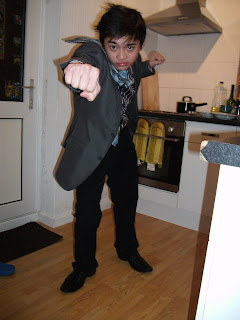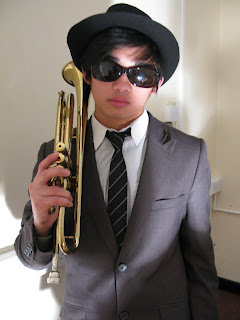Friday, 28 January 2011
Music Magazine Experiment
Above is an experiment of my front cover. I plan on designing my front cover similar to this.
And this graphic design above is what I plan to use as a background for my contents page and double page spread.
Friday, 21 January 2011
Photograph Taking
A couple of days ago I was intending to take photographs with my collegues. It didn't turn out so well because they didn't seem quite focused. What I now intend to do is to take photographs in the weekend, which is a non-school-day, with my friends, to be a lot more sure that photos will be taken. To achieve this, I am planning to use facebook or any other social websites as an event organizer to organize the time and date of a photoshoot.
Although, I have some stock photographs which I may possibly use for this magazine. Here are some of them:
I intend to take more photographs which would relate more to my magazine's genre.
Edit: Some more photographs which I took:
Although, I have some stock photographs which I may possibly use for this magazine. Here are some of them:
I intend to take more photographs which would relate more to my magazine's genre.
Edit: Some more photographs which I took:
Friday, 7 January 2011
Music Magazine Production
The very first step I had in mind as soon as the production time started was to do research on different brand types of music magazines by different brands such as NME, KERRANG, etc., work out the techniques they've used and identify the codes and conventions of this variety of magazines.
The types of information which I will be looking for in my research are: print glossaries and meanings, codes and conventions for magazines, magazine front covers, contents pages, and double page spreads.
By researching for magazines, codes and conventions, genre, and target audience, I should stumble upon the world famous internet. I could search for past students' blogs to learn their ideas about magazines and take influence from their views to my own when breaking down a magazine.
From my research of front covers of music magazines, I noticed that most of them kept their title's appearance on every issue (if not all of them). Sometimes, their title only changes colour, which depends on the magazine's colour scheme. Also, the title's appearance is always kept simple and legible. Mojo's title is just "MOJO" in capitals, sans serif, with an addietional "The Music Magazine" placed on part of "MOJO"; Q magazine's title only has a white capital "Q" on a red rectangle; etc. these techniques make the magazine logo "title" adaptive to multiple themes to blend in, and to keep their corporate identity recognizable. Music magazines also usually places their title on the top of the page. This makes the magazine cover's composition balanced.
All music magazine front covers which I've researched so far contain sell lines. The effect which this creates is that it entices the reader, of the very catchy story (which is possibly added with puns, celebrity names, punch lines, etc.), to buy the magazine. Although, the sell lines are rarely just put randomly on the page - they mostly follow a colour scheme and pattern which depends on the magazine's overall design. This makes the magazine's composition more eye-catching, and, as sell lines are sell lines, they also make them as legible as possibly by choosing certain fonts.
Music magazines usually vary their main photograph: close-up shots usually lock eye contact towards the viewer to gain their attention; long shots and mid-shots alike usually show off the main character's body and'or pose to make the viewer idolize or mesmorieze at the person's body; group photographs are usually of band members photographed doing actions; although, whatever the magazine front cover's main photo is, they are mostly removed off their background and replaced with a colour which suits the magazine's colour scheme. The people which music magazines usually feature as front cover photos are of well-known celebrities - this makes the veiwer enticed to buy the magazine if they idolize the certain person in the front cover.
Some magazine front covers, I've noticed, place celebrity names on them to entice the reader to purchase the magazine if they see that the magazine contains a topic about a favourite celebrity of theirs. Also, they seem to use this technique as a "Plan B" to widen their target audience just in case the person doesn't like the person on the front cover.
From researching contents pages, I noticed that they mostly use the same techniques. Most techniques which music magazines use (which may be the codes and conventions) are: they add photographs in of the magazine's best stories, and some are numbered by their page number, sometimes, all photos are numbered; headlines are usually numbered and a different colour from the sub headline; the headlines and sub headlines are usually composed in columns but sometimes, when a photo would overlap on the text, the designer would usually go around the photo.
I intend my magazine's target audience to be: of any ethnicity; hip-hop, rock, pop, RnB, punk, and grime type of music people; middle-ages; male.
I will attempt to attract my target audience by adding photographs of people in each music genre throughout the magazine, especially the front cover. The main photograph should depend on the photographs which I will be taking when working with some friends. The effect which this should achieve is that the reader would idolize the photos to make the audience buy the magazine, enjoy the magazine, and buy the next issue.
My magazine's colour scheme will depend on my main photograph; if my main photograph is colourful, I plan to make the text colours of the sell lines colourful; if my main photograph limits in colour (somewhat like black, white, and red), I intend to compose my front cover's colour scheme to be dark.
A simple looking logo would be the best choice for my magazine to avoid getting in the magazine's composition. I intend the logo to be behind the main character to make the magazine not seem desperate of brand attention and to prioritize the main person in the photograph.
Sell lines which will attract people interested in each music genre I plan as target audience should be added. I intend these sell lines to be planned and designed in a way that the stories are explosive: I could change the colours, size, font type, etc. of different lines for different kinds of effects.
The types of information which I will be looking for in my research are: print glossaries and meanings, codes and conventions for magazines, magazine front covers, contents pages, and double page spreads.
By researching for magazines, codes and conventions, genre, and target audience, I should stumble upon the world famous internet. I could search for past students' blogs to learn their ideas about magazines and take influence from their views to my own when breaking down a magazine.
From my research of front covers of music magazines, I noticed that most of them kept their title's appearance on every issue (if not all of them). Sometimes, their title only changes colour, which depends on the magazine's colour scheme. Also, the title's appearance is always kept simple and legible. Mojo's title is just "MOJO" in capitals, sans serif, with an addietional "The Music Magazine" placed on part of "MOJO"; Q magazine's title only has a white capital "Q" on a red rectangle; etc. these techniques make the magazine logo "title" adaptive to multiple themes to blend in, and to keep their corporate identity recognizable. Music magazines also usually places their title on the top of the page. This makes the magazine cover's composition balanced.
All music magazine front covers which I've researched so far contain sell lines. The effect which this creates is that it entices the reader, of the very catchy story (which is possibly added with puns, celebrity names, punch lines, etc.), to buy the magazine. Although, the sell lines are rarely just put randomly on the page - they mostly follow a colour scheme and pattern which depends on the magazine's overall design. This makes the magazine's composition more eye-catching, and, as sell lines are sell lines, they also make them as legible as possibly by choosing certain fonts.
Music magazines usually vary their main photograph: close-up shots usually lock eye contact towards the viewer to gain their attention; long shots and mid-shots alike usually show off the main character's body and'or pose to make the viewer idolize or mesmorieze at the person's body; group photographs are usually of band members photographed doing actions; although, whatever the magazine front cover's main photo is, they are mostly removed off their background and replaced with a colour which suits the magazine's colour scheme. The people which music magazines usually feature as front cover photos are of well-known celebrities - this makes the veiwer enticed to buy the magazine if they idolize the certain person in the front cover.
Some magazine front covers, I've noticed, place celebrity names on them to entice the reader to purchase the magazine if they see that the magazine contains a topic about a favourite celebrity of theirs. Also, they seem to use this technique as a "Plan B" to widen their target audience just in case the person doesn't like the person on the front cover.
From researching contents pages, I noticed that they mostly use the same techniques. Most techniques which music magazines use (which may be the codes and conventions) are: they add photographs in of the magazine's best stories, and some are numbered by their page number, sometimes, all photos are numbered; headlines are usually numbered and a different colour from the sub headline; the headlines and sub headlines are usually composed in columns but sometimes, when a photo would overlap on the text, the designer would usually go around the photo.
I intend my magazine's target audience to be: of any ethnicity; hip-hop, rock, pop, RnB, punk, and grime type of music people; middle-ages; male.
I will attempt to attract my target audience by adding photographs of people in each music genre throughout the magazine, especially the front cover. The main photograph should depend on the photographs which I will be taking when working with some friends. The effect which this should achieve is that the reader would idolize the photos to make the audience buy the magazine, enjoy the magazine, and buy the next issue.
My magazine's colour scheme will depend on my main photograph; if my main photograph is colourful, I plan to make the text colours of the sell lines colourful; if my main photograph limits in colour (somewhat like black, white, and red), I intend to compose my front cover's colour scheme to be dark.
A simple looking logo would be the best choice for my magazine to avoid getting in the magazine's composition. I intend the logo to be behind the main character to make the magazine not seem desperate of brand attention and to prioritize the main person in the photograph.
Sell lines which will attract people interested in each music genre I plan as target audience should be added. I intend these sell lines to be planned and designed in a way that the stories are explosive: I could change the colours, size, font type, etc. of different lines for different kinds of effects.
Subscribe to:
Comments (Atom)























